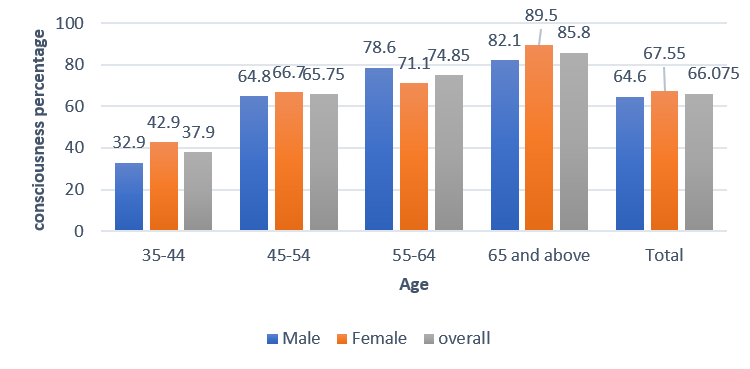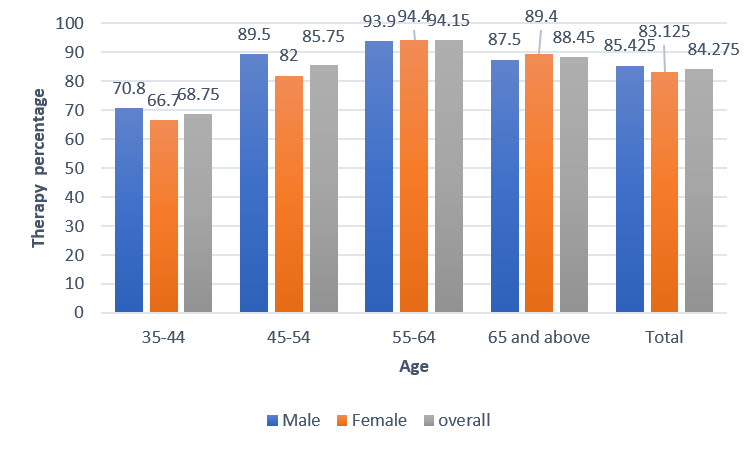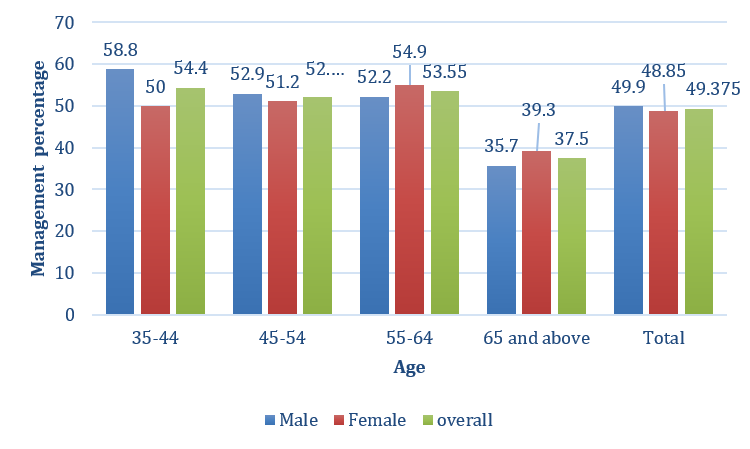Cross-sectional study of cardiovascular disease awareness and therapy management among hypertensive patients in rural areas in the Nellore district of Andhra Pradesh State
Abstract
Recent Indian study protocol designed for the supervision of cardiovascular disease instructed as well as better therapeutic achievement underneath the accustomed cardiovascular disease inhabitants. After all, a few people (25%) of heart-related problems inhabitants being conscious, 80% of the people were treated; besides just 20% were composed. This study was conducted as a cross-sectional study laminated arbitrary examine and inspected during the period of 4th Mar 2017 to 3rd July 2017 in the form of order. The model framework was put up pedestal scheduled, the portal system of the area inhabitants record as of inhabitants in the sequence of Nellore. Analytical clue, hypertension situation, and way of life behavior of the contributors were revealed. Hereby observed hypertension occurrence, consciousness, therapy, management, and drugs. The study appearance 57.2% of observed inhabitants to exist confidential the same as blood pressure living being conscious of their earlier analysis of blood pressure. This deliberation has been observed as a laminated casual inspect characterizing the Indian developed inhabitants in city areas of Nellore, India. As well as-discussed training procedure was attended with employing a definitive covenant and tool and makes certain the superiority of the fact compilation agenda. This hypertension wellbeing control can be taught the communal base and it prevents the public from cardiovascular disease avoidance plan may be effectual and humanizing to manage the blood pressure.
Keywords
CVD, Consciousness, Hypertension, Management, Occurrence, Therapy
Introduction
Hypertension (HTN) is one of the health care problems and accounts for increased mortality in urban populations in India. Elevated blood pressure is the main cause of cardiovascular disease like ischemic heart disease and cerebrovascular disease like stroke (Hansson, 2005; Lloyd-Jones, Adams, & Carnethon, 2009). In particular, there has been an alarming increase in high blood pressure prevalence in rural populations in India, for instance, augmented high blood pressure radically, as of 7.15% during 1960 toward 20% during 2005 mitigates the importance of awareness and health education among hypertensive patients in Indian rural populations. Ever-increasing incidence of high blood pressure necessitates improved consciousness amongst the common rural population. Recent Indian study protocol designed for the supervision of cardiovascular disease patients as well as better therapeutic achievement underneath the accustomed cardiovascular disease inhabitants. It has been observed that a few people (25%) were conscious of heart-related problems, 80% of the people were treated, besides just 20% were composed (Lefler & Bondy, 2004; Sit et al., 2010). This indicates that just a little percentage is exaggerated, individuals being along with high blood pressure who can manage their situation. The present investigation was conducted in the Nellore district of Andhra Pradesh State. The inhabitants of 153,766 populace above 35 aged lived in the city of Nellore. The aforementioned populace was initially alienated keen on 8 stratums bestow to the site of citizen house, and comparative portion as of situate single to nine was observed. Though, presently are not having to sufficiently confined information about popularity, consciousness, therapeutic management and to educate the peoples in Nellore, Andhra Pradesh, India (Stewart & Vitello-Cicciu, 1998). The present investigation is aimed to study cardiovascular disease popularity and its therapy management in rural areas of Nellore District of Andhra Pradesh State in India.
Method
This study was conducted as a cross-sectional study carried out during the period of 4th Mar 2017 to 3rd July 2017. This questionnaire-based survey has been approved by the Institutional Ethical committee. The model framework was put up on a pedestal scheduled, the portal system of the area inhabitants record as of inhabitants in a sequence of Nellore (Pilote, Dasgupta, Guru, & Humphires, 2007). The respondents aged between 35-74 of either sex were included in this study. The common vacationer, persons, have got admitted to the hospital, in addition to persons along with emotional destruction or not capable to converse orally was excluded from the study (Rosenfeld, 2006).
Data collection method
Information was composed in wellbeing assessment allowance from Nellore society wellbeing care or this allied to provincial wellbeing care in the urban range of the social group inhabited location (Ryan, 2005). The housebound, consultation and wellbeing assessment was assumed to both rural and urban areas. The information was composed through educated community health nurses' scholars with the help of discussion themselves with the peoples, including cardiovascular disease patient's situation and wellbeing investigation interventional dimension high blood pressure. Self-report questionnaire the ascetic-statement opinion poll integrated the communal analytical clue, hypertension, and way of life behaviour of the contributor (DeVon, Ryan, Ochs, & Shapiro, 2008).
Results
Analysis of the data revealed that the hypertension situation and way of life behaviour of the contributor. The consciousness of hypertension, therapy, management, and drug-related problems in blood pressure of each gender was shown in Table 1.
|
Age group |
Consciousness |
Therapy |
Management |
||||||
|---|---|---|---|---|---|---|---|---|---|
|
(years) |
Male |
Female |
Overall |
Male |
Female |
Overall |
Male |
Female |
Overall |
|
35 - 44 |
24 (32.9) |
6 (42.9) |
30 (37.9) |
17 (70.8) |
4 (66.7) |
21 (68.75) |
10 (58.8) |
2 (50.0) |
12 (54.4) |
|
45 - 54 |
57 (64.8) |
50 (66.7) |
107 (65.75) |
51 (89.5) |
41 (82.0) |
92 (85.75) |
27 (52.9) |
21 (51.2) |
48 (52.05) |
|
55 - 64 |
33 (78.6) |
54 (71.1) |
87 (74.85) |
31 (93.9) |
51 (94.4) |
82 (94.15) |
48 (52.2) |
28 (54.9) |
76 (53.55) |
|
65 and above |
32 (82.1) |
94 (89.5) |
126 (85.8) |
28 (87.5) |
84 (89.4) |
112 (88.45) |
10 (35.7) |
33 (39.3) |
43 (37.5) |
|
P-Value |
P<0.002 |
P<0.002 |
P<0.002 |
P<0.002 |
P<0.002 |
P<0.002 |
0.063 |
0.351 |
0.012 |



Table 1 and Figure 1 represent the percentage of consciousness about hypertension in the age group from 35 – 44 years for males was found to be 32.9, the females was found to be 42.9, and the overall percentage was 37.9. The consciousness about hypertension was high for females than males in the age range between 35-44 years. The percentage of consciousness about hypertension in the age group from 45 – 54 years for males was found to be 64.8, the females was found to be 66.7, and the overall percentage was 65.75, respectively. The consciousness about hypertension was high for females than males in the age range between 45 - 54 years. The percentage of consciousness about hypertension in the age group from 55 – 64 years for males was found to be 78.6, the females was found to be 71.1, and the overall percentage was 74.85. The consciousness about hypertension was high for males than females in the age range between 55-64 years. The percentage of consciousness about hypertension in the age group from 65 years and above for males was 82.1, the female was 89.5, and the overall percentage was 85.8. The consciousness about hypertension was high for females than males in the age range between 65 – above 65 years. The overall consciousness percentage about hypertension for the age groups ranging from 35 – above 65 years was superior in females (67.55) than in males (64.6) (P<0.002). The overall percentage of consciousness about hypertension was high (85.8) in the age range between 65 – above 65years than other age groups (35 – 64 years).
Table 1 and Figure 2 represent the percentage of therapy undertaken for hypertension in the different age group. The age group from 35 – 44 years for males was found to be 70.8, the females was found to be 66.7, and the overall percentage was found to be 68.75. The therapy about hypertension was high for males than females in the age range between 35-44 years. The percentage of therapy undertaken for hypertension in the age group from 45 – 54 years for males was found to be 89.5, the females was found to be 82.0, and the overall percentage was found to be 85.75 respectively. The therapy about hypertension was high for males than females in the age range between 45 - 54 years. The percentage of therapy undertaken for hypertension in the age group from 55 – 64 years for males was found to be 93.9, the females was found to be 94.4, and the overall percentage was 94.15 respectively. The therapy about hypertension was high for females than males in the age range between 55-64 years. The percentage of therapy undertaken for hypertension in the age group from 65 years and above for males was found to be 87.5, the females was found to be 89.4, and the overall percentage was 88.45. The therapy about hypertension was high for females than males in the age range between 65 – above 65 years. The overall therapy percentage undertaken for hypertension for the age groups ranging from 35 – above 65 years was superior in males (85.425) than in females (83.125) (P<0.002). The overall percentage of therapy about hypertension was high in the age range between 55 – 64 years than other experimented age groups.
The percentage of management of hypertension in the age group from 35 – 44 years for males was 58.8, the female was 50.0, and the overall percentage was 54.4. The management of hypertension was high for males than females in the age range between 35-44 years. The percentage of management of hypertension in the age group from 45 – 54 years for males was 52.9, the female was 51.2, and the overall percentage was 52.05. The management of hypertension was high for males than females in the age range between 45 - 54 years. The percentage of management of hypertension in the age group from 55 – 64 years for males was 52.2, the female was 54.9, and the overall percentage was 53.55. The management of hypertension was high for females than males in the age range between 55-64 years. The percentage of management of hypertension in the age group from 65 years and above for males was 35.7, the female was 39.3, and the overall percentage was 37.5. The management of hypertension was high for females than males in the age range between 65 – above 65 years. The overall management of hypertension for the age groups ranging from 35 – above 65 years was superior in males (49.9) than in females (48.85) (P<0.002). The overall percentage of management of hypertension was high in the age range between 35 – 44 years than other experimented age groups (Table 1 and Figure 3).
Discussion
The present data revealed that the cardiovascular awareness of hypertensive subjects aged between 35-65 living in a rural area of Nellore, Andhra Pradesh, India. Three main indicators viz., consciousness, therapy and management related to hypertension were studied and analysed. There were 1500 respondents participated in this research with a passive involvement of 85.7% with good turnout throughout the study period (Berra, Miller, & Jennings, 2011; Shirani, Kelishadi, Sarrafzadegan, Khosravi, & Sadri, 2009). In addition to that, a complete training procedure has been deliberated to local health care community workers about the awareness and standard clinical guides has been taught to them using standard clinical practice guidelines (Marshall, Sahm, & McCarthy, 2012; Morrow et al., 2007). This training program may provide an update for the community workers and also provide a definitive covenant and makes certain the superiority of the fact compilation agenda. From this study, it is inferred that a decrease in awareness of hypertensive therapy and management was observed in 35 -54 age group despite their consciousness on hypertension. This may be due to an increase in their socio-economic well being and sedentary lifestyle, including high salty and high-fat food consumption (Jo et al., 2001; Rampal, Rampal, Azhar, & Rahman, 2008). On the other side, an increase in awareness on all the three tested parameters was observed in the age group 55 to 65 and above. The hypertension dimension and accurate certification of participant antiquity of blood pressure and their blood pressure drug handling were carefully audited (Gu, Reynolds, Wu, & Chen, 2002; Heinrich, 2012).
Conclusion
It confirmed that blood pressure or heart-related disease was exceedingly common in the study region, and there the percentage of consciousness, therapy and management were related superior to preceding in India investigation has been completed, possibly gratitude to the topical fast improvement of commonwealth established wellbeing utility plan for humanizing the control of blood pressure. The present conclusion participates in important guideline instruction for decision-makers and wellbeing sources. This hypertension wellbeing control can be taught the communal base and it prevents the public from cardiovascular disease avoidance plan may be effectual and humanizing to manage the blood pressure. Hereby we observed these people are very inattentive to abiding to prescribed drugs to control hypertension. Here one appeal is very important for society and community health nursing have to intend an ethnically susceptible agenda address towering-peril community such as elder age of female and who is staying alone, additionally developing to the therapeutic management of females hypertensive to minimize and reducing the difficulty of cardiovascular disease for the peoples of the rural and urban areas in India.